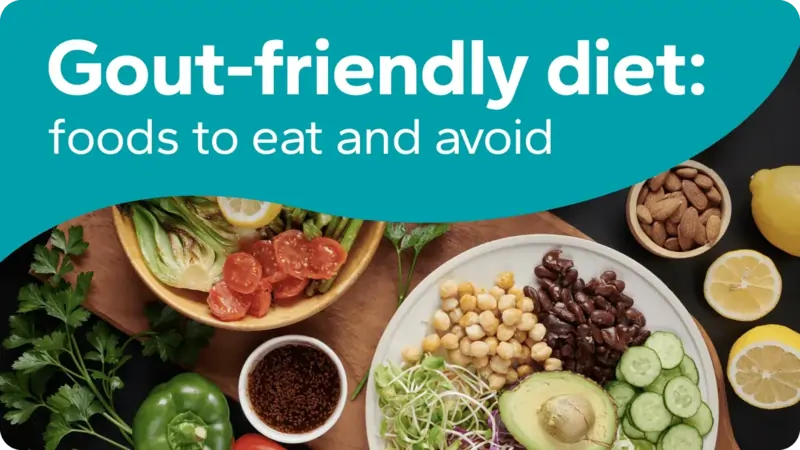Gout (Low Purine) Diet: Best Foods to Eat & What to Avoid
A low-purine diet is essential for managing gout, a form of arthritis caused by excess uric acid in the body. This diet focuses on reducing purine-rich foods that can trigger painful flare-ups. The best foods to eat include fruits, vegetables, whole grains, low-fat dairy, and plenty of water.
It’s important to avoid high-purine items like red meat, organ meats, certain seafood, and alcohol. Making smart dietary choices can help lower uric acid levels and reduce the risk of gout attacks.
Gout: What is it?
Gout is a type of inflammatory arthritis that causes swelling and damage to your joints. When your body accumulates uric acid, gout develops.
The big toe joint is most frequently affected by gout. However, it may also impact other joints, such as your:
- Knees.
- Ankles.
- Feet.
- Wrists and hands.
- Elbows.
Gout attacks, often known as flare-ups, are periods of recurrent gout symptoms. To reduce uric acid levels and the frequency of future gout attacks, a medical professional will recommend drugs and dietary adjustments.
The Gout Diet: What is it?
Elevated blood levels of uric acid are the cause of gout. Excess uric acid causes painful and swollen joints by forming sharp crystals. However, a low-purine diet can help lower your body’s uric acid levels. Lowering uric acid levels can lessen gout attacks by preventing the formation of new crystals.
A low-purine diet: what is it?
Certain foods and beverages naturally contain compounds called purines. Uric acid is a consequence of these substances’ breakdown in your body. To lower uric acid, a low-purine diet minimizes foods and beverages that contain the most purines. Additionally, it promotes a few specific meals that may lower your body’s uric acid levels.
Who can benefit from a low-purine diet?
People with gout:
Uric acid crystals that accumulate in the joints cause gout, a kind of arthritis. A low-purine diet can lower uric acid levels and decrease the frequency and intensity of gout attacks.
People who have hyperuricemia:
Hyperuricemia is a disorder marked by excessively elevated blood uric acid levels. Even without gout, high uric acid levels might cause additional health issues. A reduced purine diet can lower those levels.
People with kidney stones:
Kidney stones can also be caused by uric acid. Kidney stones caused by uric acid can be prevented with a low-purine diet.
Individuals who might have received organ transplants as well.
The Objectives of a Gout Diet:
A gout diet’s objectives are to:
- Develop healthy eating habits and a healthy weight.
- Avoid some purine-containing foods, but not all of them.
- Add a few meals that help regulate uric acid levels.
Eating healthful foods in moderation is a good general rule.
Diet details:
The general guidelines of a diet for gout adhere to standard recommendations for healthy diets:
Reducing weight. Gout is more likely to develop in people who are overweight, and it is less likely to occur in people who are losing weight. Even without following a purine-restricted diet, research indicates that cutting calories and weight can lower uric acid levels and lessen the frequency of gout attacks. Losing weight also decreases the total load on joints.
Complex carbohydrates. Consume more whole grains, fruits, and vegetables because they contain complex carbs. Limit your intake of naturally sweet fruit juices and stay away from foods and drinks that contain high-fructose corn syrup.
Water. Drink plenty of water to be well hydrated.
Fats. Reduce your intake of red meat, fatty poultry, and high-fat dairy items as sources of saturated fats.
Proteins. For protein, prioritize lean meat and chicken, low-fat dairy products, and lentils.
Which foods are ideal to consume when suffering from gout?
Although consuming specific foods won’t cure gout, research indicates that several meals and beverages may help lower your body’s uric acid levels. For instance:
Skim milk. Drinking skim milk may help lower uric acid and gout flare-ups, according to some preliminary studies. It decreases your body’s inflammatory reaction to uric acid crystals in your joints and accelerates the excretion of uric acid in your urine.
Cherries. Early findings from studies on the advantages of cherries and cherry juice for gout symptom management are encouraging. In addition to their well-known anti-inflammatory qualities, cherries may also lower your body’s uric acid levels.
Coffee. Although coffee is said to be acidic, the acid in coffee is not the same as uric acid. There are several ways that regular coffee consumption can lower your uric acid levels. It increases the rate of excretion while slowing the conversion of purine to uric acid.
Water. Gout symptoms are less common in people who consume five to eight glasses of water each day. This makes sense because your kidneys eliminate uric acid from your urine by using water. Water is beneficial to renal health as well. Gout can result from several factors, including impaired kidney function.
Nonetheless, a lot of medical professionals would rather discuss broad dietary recommendations than specific foods. They advise you to:
Change up the sources of your protein. You’ll be fine if you consume a variety of foods and avoid the worst foods mentioned above, even though some meats and shellfish have higher uric acid levels.
Eat fruits and veggies. Purines are generally low, but even those with larger levels have not been demonstrated to have an impact on gout symptoms. The advantages are also valuable.
Enjoy grains (except oats). Except for oats, rice, pasta, and cereals are all good for gout. To help control blood sugar, pick whole grains at least half the time and be wary of packaged goods that include additional high fructose corn syrup.
Which foods worsen gout?
The following are the top ten foods and beverages that cause gout:
- Sweets and sugary beverages. The half fructose that makes up regular table sugar decomposes into uric acid. Gout can be brought on by any food or beverage that contains more sugar.
- Corn syrup with high fructose. This is a concentrated type of fructose. High fructose corn syrup can be found in a variety of packaged food items that you might not anticipate if you start reading labels.
- Alcohol. Alcohol stops your kidneys from getting rid of uric acid, so it keeps building up in your body. This is true even though not all alcoholic beverages contain a lot of purines.
- Organ meats. These consist of kidneys, liver, brains, and triple sweetbreads.
- Game meats. In the Middle Ages, gout was referred to as the “rich man’s disease” because of specialties like geese, veal, and venison.
- Some seafood, such as haddock, codfish, tuna, trout, herring, scallops, and mussels.
- Red meats, such as bacon, lamb, beef, and pork.
- Turkey. Still, there are a lot of purines in this thinner meat. In particular, avoid prepared deli turkey.
- Meat and gravy sauces.
- Yeast as well as its extract.
What are the benefits of a low-purine diet?
Lowering uric acid. Individuals who are predisposed to hyperuricemia might be able to control their condition through diet to avoid complications like kidney stones and gout. Those who already have kidney stones or gout may be able to stop or at least slow the formation of new uric acid crystals in their kidneys or joints.
Losing weight. A further benefit of avoiding high-purine foods like red meats and sweets is that you may lose weight. Excess weight gain and accompanying metabolic disorders like obesity, diabetes, and cardiovascular disease are strongly linked to gout. Losing weight reduces your chance of getting gout and, by relieving joint stress, helps reduce gout symptoms.
Reducing medication. Medication is the best way to manage gout, and diet is not meant to take its place. However, following a healthy diet could reduce the amount of medicine you need.
What are the disadvantages of following a low-purine diet?
It’s restrictive. A low-purine diet is a permanent lifestyle modification for those with hyperuricemia. Additionally, it targets several popular indulgences, such as alcohol, sugar, and sweets. Giving them up permanently may seem unattainable to some people, particularly if they are merely receiving supplementary therapy. You must follow it to get the benefits, just like with most diets.
It restricts supplies of omega-3. One of the most significant dietary sources of omega-3 fatty acids is seafood, and many of these are restricted by the low-purine diet. Among the numerous well-known health advantages of omega-3 fatty acids is their ability to reduce inflammation and arthritis-related joint discomfort. Limiting seafood can exacerbate the omega-3 deficiency that many Americans already have. Supplements containing fish oil are acceptable on this diet, though.
It is not a cure. Dietary changes may have some effect on blood uric acid levels, but not as much as prescription drugs. Combining them is the best course of action. Some contend that as compared to medication, the advantages of the diet have not been shown to outweigh the inconvenience. However, gout is frequently difficult to adequately manage with medicine alone. Many people in these situations value being able to take proactive steps to lessen their symptoms.
A sample menu for the Gout diet:
This is what you could eat on a gout diet on an average day.
Morning meal
- Unsweetened, whole-grain cereal with skim or reduced-fat milk
- One cup of fresh strawberries
- Water and Coffee
Lunch
- Two-ounce slices of roasted chicken breast served with mustard on a whole-grain bun.
- Balsamic vinegar, olive oil dressing, 1 tablespoon of almonds, and a mixed green salad.
- Water or low-fat or skim milk.
Afternoon snack
- 1 cup fresh cherries
- Water
Dinner
- Roasted salmon (3 to 4 ounces)
- Roasted or steamed green beans
- 1/2 to 1 cup whole-grain pasta with olive oil and lemon pepper
- Water
- Low-fat yogurt
- 1 cup fresh melon
- Caffeine-free beverages, such as herbal tea
Findings
Limiting uric acid synthesis and increasing its excretion can be achieved by adhering to a gout diet. It is unlikely that a gout diet will reduce blood uric acid levels sufficiently to treat gout without medication. However, it might lessen the frequency and intensity of assaults.
By assisting you in reaching and maintaining a healthy weight, a gout diet, calorie restriction, and regular exercise can also enhance your general health.
Summary
One form of arthritis that results in excruciating joint inflammation is gout. Crystals in the joints are caused by an excess of uric acid in the blood. The diet helps control gout by reducing uric acid levels.
Limiting high-purine foods consuming low-purine foods, drinking lots of water, and staying away from sugary drinks and alcohol are all part of a gout-friendly diet. Although no diet may stop gout flare-ups, following these tips can help control symptoms and reduce the frequency of episodes.
FAQs
Can gout be treated with eggs?
Eggs can be included in a gout sufferer’s diet. Due to their low purine content, eggs may help reduce blood uric acid levels. Some meals include purines, which the body subsequently transforms into uric acid.
Which foods are beneficial for gout?
Consume more whole grains, fruits, and vegetables because they contain complex carbs. Limit your intake of naturally sweet fruit juices and stay away from foods and drinks that contain high-fructose corn syrup. Water. Drink plenty of water to be well hydrated.
Does milk cause gout?
Would you like some frozen yogurt or a big glass of cold milk? Proceed. Research indicates that consuming low-fat dairy products and drinking low-fat milk will lower your risk of gout attacks and uric acid levels. Uric acid excretion in the urine is facilitated by the proteins in milk.
Are bananas harmful to gout?
Gout sufferers can benefit from eating bananas because they are high in vitamin C and low in purines. Recurrent gout attacks can be prevented and blood uric acid levels lowered by incorporating more low-purine foods, such as bananas, into your diet.
In ten minutes, how can gout be treated?
Flare-ups of gout usually last a few weeks and don’t go away after ten minutes. To reduce inflammation and alleviate gout symptoms, take your gout flare medication. To relieve the discomfort as soon as possible, elevate your swollen joint and apply an ice pack to cool it.
References
- Can the foods you eat help to control gout? (n.d.). Mayo Clinic. https://www.mayoclinic.org/healthy-lifestyle/nutrition-and-healthy-eating/in-depth/gout-diet/art-20048524
- Professional, C. C. M. (2024b, May 6). Gout Low purine diet. Cleveland Clinic. https://my.clevelandclinic.org/health/treatments/22548-gout-low-purine-diet
- Gout diet: Foods to eat and those to avoid. (n.d.). WebMD. https://www.webmd.com/arthritis/gout-diet-curb-flares
- Gout. (2025, February 7). Cleveland Clinic. https://my.clevelandclinic.org/health/diseases/4755-gout







